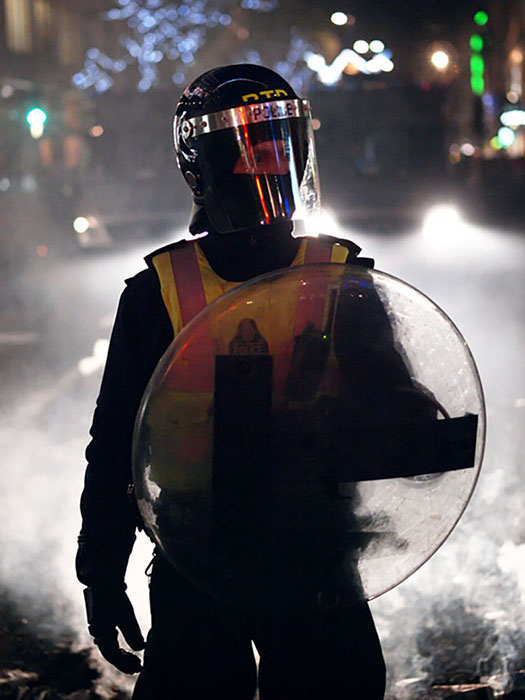6.3 Collective Behavior
In order to better understand the behavior of the demonstrators, let’s consider some of the ways sociologists have thought about how individuals behave in groups . Early collective behavior theories (LeBon 1895; Blumer 1969) focused on the irrationality of crowds. Eventually, those theorists who viewed crowds as uncontrolled groups of irrational people were supplanted by theorists who viewed the behavior some crowds engaged in as the rational behavior of logical beings.
6.3.1 Emergent-Norm Perspective
Sociologists Ralph Turner and Lewis Killian (1993) developed emergent norm theory to describe how and why the norms experienced by people in a crowd may be disparate and fluctuating. They emphasize the importance of these norms in shaping crowd behavior, especially those norms that shift quickly in response to changing external factors. Emergent norm theory asserts that, in this circumstance, people perceive and respond to the crowd situation with their particular (individual) set of norms, which may change as the crowd experience evolves. This focus on the individual component of interaction reflects a symbolic interactionist perspective.
The emergent norm process begins when people suddenly find themselves in a new situation, or when an existing situation suddenly becomes strange or unfamiliar Once individuals find themselves in a situation ungoverned by previously established norms, they interact in small groups to develop new guidelines on how to behave. According to the emergent-norm perspective, crowds are not irrational, impulsive, uncontrolled groups. Instead, norms develop and are accepted as they fit a situation. While this theory offers insight into why norms develop, it leaves undefined the nature of norms, how they come to be accepted by the crowd, and how they spread through the crowd.
6.3.2 Assembling Perspective
Assembling perspective, an Interactionist approach developed by Clark McPhail (1991), credits individuals in crowds as rational beings. Mc Phail focused on the processes associated with crowd behavior and the lifecycle of gatherings. He identified instances of convergent or collective behavior.
6.3.3 Value-Added Theory
Neil Smelser (1962) developed value-added theory as a functionalist theory to describe the conditions that must be in place for collective behavior to occur. Each condition adds to the likelihood that collective behavior will occur. The first condition is structural conduciveness, which occurs when people are aware of the problem and have the opportunity to gather, ideally in an open area. Structural strain, the second condition, refers to people’s expectations about the situation at hand being unmet, causing tension and strain. The next condition is the growth and spread of a generalized belief, wherein a problem is clearly identified and attributed to a person or group. Fourth, precipitating factors spur collective behavior; this is the emergence of a dramatic event. The fifth condition is mobilization for action, when leaders emerge to direct a crowd to action. The final condition relates to action by the agents. Called social control, it is the only way to end the collective behavior episode (Smelser 1962).
A real-life example of these conditions occurred after the fatal police shooting of Michael Brown, an unarmed eighteen-year-old African American, in Ferguson, MO on August 9, 2014. The shooting drew national attention almost immediately. A large group of mostly Black, local residents assembled in protest—a classic example of structural conduciveness. When the community perceived that the police were not acting in the people’s interest and were withholding the name of the officer, structural strain became evident.
A growing generalized belief evolved as the crowd of protesters were met with heavily armed police in military-style protective uniforms accompanied by an armored vehicle. The precipitating factor of the arrival of the police spurred greater collective behavior as the residents mobilized by assembling a parade down the street. Ultimately they were met with tear gas, pepper spray, and rubber bullets used by the police acting as agents of social control. The element of social control escalated over the following days until August 18, when the governor called in the National GFuard. One of the remarkable things about the Portland protests is that they were not subdued when the president deployed federal forces to escalate social control.

Figure 6.5 Agents of social control bring collective behavior to an end.
As theories of collective behavior have developed, we see a shift in perspective away from thinking about group behavior as irrational or impulsive, and towards an understanding of the ways that, as Aldon Morris asserts, collective emotional responses to injustice, such as anger and empathy are necessary agents of transformation (2021).
Emergent norms theory, assembling perspective, and value added theory are each useful for helping us understand the ways people respond to urgent social problems with collective behavior and actions. We see these elements were certainly present in the 2014 demonstrations, and we see them echoed in the demonstrations of 2020. However, the sustained scale and significant impact of #BlackLivesMarter organizing owes much to the sustained social movement building that both informed and answered initial collective responses.
6.3.4 Licenses and Attributions for Collective Behavior
6.3 is adapted from “Introduction to Sociology 3e, 21.1 Collective Behavior” by May 31, 2022 OpenStax. Textbook content produced by OpenStax is licensed under a Creative Commons Attribution License CC BY 4.0.
Modifications: Lightly edited section content and applied it specifically to Portland demonstrations.
Figure 6.5 Agents of social control bring collective behavior to an end. (Credit: hozinja/flickr)
Eric Hossinger https://www.flickr.com/photos/hozinja/5248122650/in/photolist-8ZL12h https://creativecommons.org/licenses/by/2.0/
